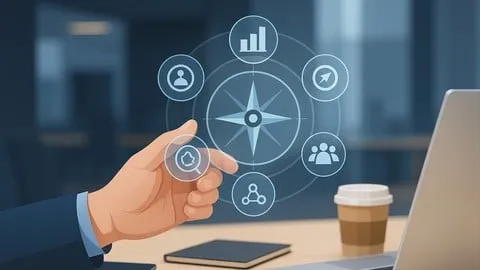Mastering The Business Analysis (With Sample Ai Prompts)
Last updated 7/2025
MP4 | Video: h264, 1920x1080 | Audio: AAC, 44.1 KHz
Language: English | Size: 786.50 MB | Duration: 4h 42m
Last updated 7/2025
MP4 | Video: h264, 1920x1080 | Audio: AAC, 44.1 KHz
Language: English | Size: 786.50 MB | Duration: 4h 42m
Comprehensive guide for writing business analysis, defining requirements
What you'll learn
Core Concepts of Software, Design, and Project Domains
Definition, Purpose, Responsibilities, and Opportunities of the Business Analyst Role
Technical and Non-Technical Competencies Required for Business Analysts
A Comprehensive Orientation for New or Transitioning Business Analysts in the Corporate World
Purpose, Scope, and Components of the Business Analysis Document
Essential and Practical Knowledge for Creating an Effective Business Analysis Document
The Importance of the Business Analysis Document from a Stakeholder Perspective
Requirements
Basic Computer Skills
Description
This comprehensive training is specially designed to help you gain the technical and personal skills that will ensure your success in a business analysis career.Throughout this course, you will explore the purpose of the business analyst role, its key activities, and the valuable opportunities it holds today and in the future business world. Staying aligned with the core objective of the training, you’ll learn the entire business analysis process from start to finish. You’ll also gain essential knowledge in areas closely connected to business analysts, such as project management, the software development life cycle (SDLC), and user experience (UX/UI) design. By the end, you’ll be fully prepared to take on the responsibilities of this role with confidence and clarity.This training will guide you through the key stages of the business analysis and requirements process—including requirement definition, prioritization, modeling, and documentation. Each topic is supported with relevant concepts and practical techniques, helping you solidify your knowledge. Through real-world examples, you’ll gain the experience needed to specialize in gathering and analyzing requirements effectively within real projects.Whether your goal is to begin a new career in this field or to deepen your current skill set, this training will help take you to the next level.
Overview
Section 1: Training Objective, Business Analyst Role and Future Opportunities
Lecture 1 Introduction
Lecture 2 Purpose of the Training and Competencies to Be Developed by the Business Analyst
Lecture 3 Future of Business Analyst Role
Lecture 4 Alternative Career Opportunities Beyond the Business Analyst Role
Section 2: Software Development Lifecycle
Lecture 5 What Will We Learn in This Section?
Lecture 6 What Is Software?
Lecture 7 Software Development Life Cycle (SDLC)
Lecture 8 Software Development Models
Lecture 9 Software Development Models – Details and Comparison
Lecture 10 The Concept of Methodology and the Relationship Between Models and Methodologies
Section 3: Project Lifecycle
Lecture 11 What Will We Learn in This Section?
Lecture 12 What Is Project and Project Management, and Why Is It Important?
Lecture 13 What Is a Process and How Is It Related to a Project?
Lecture 14 What Is a Stakeholder?
Lecture 15 Knowledge Areas in Project Management
Lecture 16 A Sample Project Process Used in Corporate Companies
Lecture 17 The BA's Collaboration with Stakeholders and Other Roles in the Project
Lecture 18 The Role of the BA in the Project and Collaboration with Project Manager
Lecture 19 Comparing the Roles of Business Analyst, Product Manager and Product Owner
Section 4: Understanding Business Needs & Creating a Business Case
Lecture 20 What Will We Learn in This Section?
Lecture 21 Understanding Business Needs and Goals
Lecture 22 Business Case in Business Analysis
Lecture 23 Identifying Stakeholders for Business Case Study
Lecture 24 Business Case Study Process
Lecture 25 Key Elements to Include in a Business Case
Lecture 26 AI-Powered Business Case Drafting - Example Prompt and Approach
Lecture 27 Complexity Value Matrix & Key Performance Indicators (KPIs)
Section 5: Requirements: Types, Constraints & Business Rules
Lecture 28 What Will We Learn in This Section?
Lecture 29 What Is a Requirement and Why Is It Needed?
Lecture 30 Effective Techniques for Writing Good Requirements
Lecture 31 Functional Requirements Explained
Lecture 32 Non-Functional Requirements Explained
Lecture 33 Understanding Constraints in Projects
Lecture 34 Comparing Requirements and Constraints
Lecture 35 Business Rules and Requirements
Section 6: Requirements Process
Lecture 36 What Will We Learn in This Section?
Lecture 37 Steps of the Requirements Process: Elicitation, Analyze, Document, Approve
Section 7: Requirements Elicitation
Lecture 38 What Will We Learn in This Lesson
Lecture 39 The Difference Between Collecting and Elicitation; Needs and Requirements
Lecture 40 Requirements Elicitation Techniques
Lecture 41 Requirements Elicitation Techniques: Workshops
Section 8: Requirements Analysis
Lecture 42 What Will We Learn In This Section
Lecture 43 Requirement Analysis And Key Steps
Lecture 44 Classification Of Requirements
Lecture 45 Business Requirements Examples
Lecture 46 Functional Requirements Examples
Lecture 47 Non-Functional Requirements Examples
Lecture 48 Prioritization Of Requirements
Lecture 49 Overview Of Prioritization Techniques
Lecture 50 Prioritization With Complexity And Value Matrix
Lecture 51 Prioritization With MoSCoW Technique
Lecture 52 Overview Of Requirement Modeling And Modeling Techniques
Lecture 53 Modeling Techniques: User Scenario
Lecture 54 Modeling Techniques: User Story
Lecture 55 Modeling Techniques: Flow Diagram
Section 9: Requirements Documentation and Approval
Lecture 56 What Will We Learn In This Section
Lecture 57 Putting It All Together: Business Requirements Document
Lecture 58 Key Sections To Include In The Business Requirements Document
Lecture 59 Final Step: Validating The Requirements
New Business Analysts: For those who are starting their careers in business analysis or transitioning from another role into this field.,Students and Recent Graduates: Ideal for those who want to begin a career in business analysis and are looking for a comprehensive preparation and foundation.,Project Managers: For project managers who want to better understand and manage business analysis requirements within project processes.,Product Managers: For those who aim to apply business analysis approaches in product development, especially for aligning customer and business needs.,Software Developers: For developers who want to better understand customer needs and business processes and apply a business analysis perspective in their projects.,HR Professionals: For HR experts looking to understand business processes in order to make better hiring decisions and optimize organizational structure.



